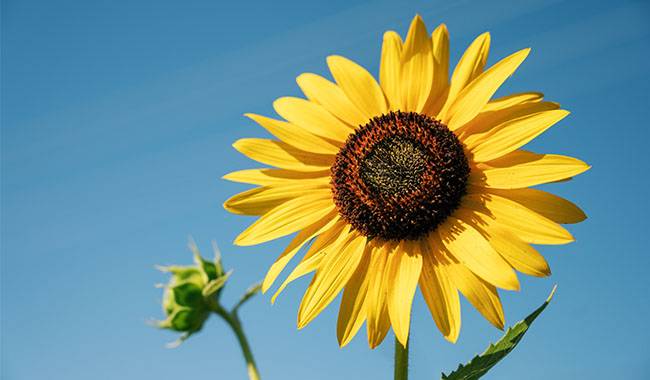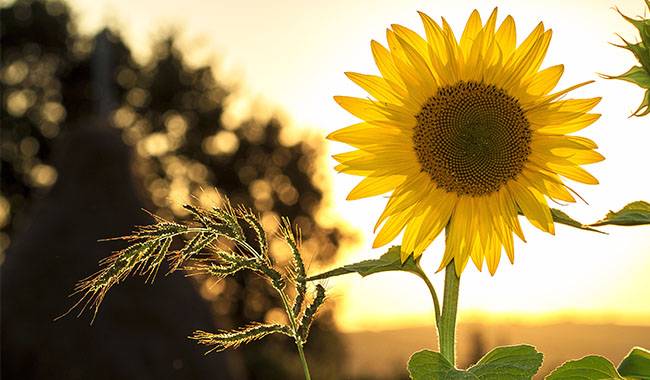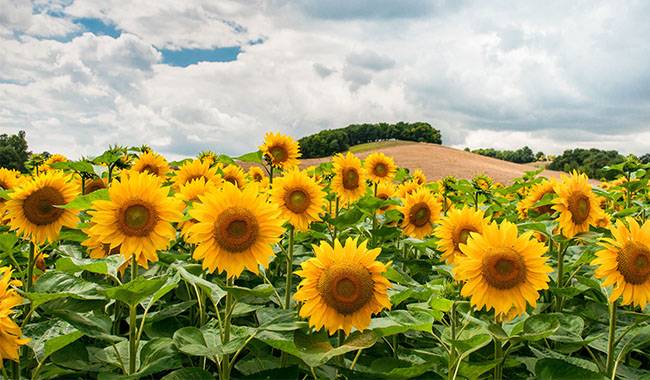
The inflorescence of the sunflower is shaped like the disk of the sun, which is why many people call it a sunflower. In the early morning, it opens to the rising sun and follows its movement until sunset. When the sunflower comes to the end of its life, it stands quietly in one position, but its flower caps are always turned to the east. Because of this characteristic, the sunflower is a symbol of devotion among many peoples.
Today, sunflowers find their place firmly on garden plots, not only as food but also as ornamental crops. In addition, they are used in landscape decorations, hedges, individual plantings, and arrangements of flowers, and this article will show you how to growing sunflowers.
SUNFLOWER DESCRIPTION
The sunflower belongs to the Asteraceae family, and the common name of the plant is Helianthus annuus, which is almost a direct translation of the words “sun” and “flower,” the Greek word for sunflower is “helios.” “It is native to the warm regions of North America, and its wild form occupies a wide area in grasslands, coniferous forests, and lowlands.
Of the 108 species of sunflower, more than 50 are grown in North and South America. The crop appeared in Europe in the 17th century. Gradually, sunflowers occupied vast areas of warm Eurasian regions, first as an ornamental crop and later as a technical and food crop. Today, varieties and hybrids have been developed that can be grown even in colder regions.
The annual sunflower is a single-stemmed plant up to 10-16foot (3-5 m) tall. The crop has a very interesting root system that can withstand the long dry periods of summer. Sunflower roots grow rapidly in the cotyledon stage, reaching lengths of 2-4inch (6-10 cm); by the 3-4 leaf stage, the roots elongate to 40inch (1 m). The root system is branched. The central taproot of adult plants grows to a depth of 10-13 feet (3-4 m) and is well resistant to soil drought. 2-3 orders of lateral roots depart from the central root. They are aligned parallel to the soil at 4-18inch (10-45cm) per level and extend from the central root to a distance of 80inch (2m). The lateral roots of sunflower form a dense network of rootlets that absorb water and nutrients. The growth of the root system stops at the inflorescence formation stage.
The leaves and stems of sunflowers are rough to the touch and densely covered with bristly hairs. The leaves are simple, large, petiolate, dark green, covering the stem up to the tip and ending in an inflorescence (a basket) composed of 2 types of flowers: ligulate and tubular.
The flowers of sunflowers are various shades of yellow. Varieties with tawny flowers are also common. The tubular, ovate flowers produce fruit after pollination. Sunflower is a cross-pollinated crop. Some cultivars may have several basket-shaped inflorescences that grow on pedicels that grow from the leaf axils.
The fruit of the sunflower is the seed. The seed is elongated, wedge-shaped, covered with a leathery pericarp, and contains 2 well-developed seedpods. It accumulates storage material in the form of oil and protein in the seedpods.
Sunflower is divided into 2 types according to size and weight.
- Oil sunflower, which is characterized by thin skin and black flesh, high oil content in seed balls (40-50% or more), and small seeds.
- The edible sunflower has a thicker and denser seed coat; it has a larger seed coat and a lower oil content (up to 25-30%).
The seeds are arranged in a circular shape. They vary in size from the edge of the pod to the center. The seeds are dormant for 1.5 to 2 months after harvest.
SUNFLOWER VARIETIES AND HYBRIDS SUITABLE FOR GROWING IN THE GARDEN
Sunflower varieties and hybrids are divided into early, medium, and late-maturing stages. Early and medium varieties are more practical for rural growth. In this case, the harvesting time allows you to prepare the plot for the next crop.
Sunflower seed varieties
Early sunflower varieties that can be recommended for planting are Skyscraper and American Giant Hybrid. They are characterized by a short vegetative period of 70 to 80 days and have a high oil content. In southern areas with a long warm period, they can be sown in two stages: in the spring in May and again by July with a good harvest. They are drought resistant and tolerate hot and dry summers well.
Other varieties are Russian Mammoth, Giant Sungold, Elf, Suntastic Yellow, Firecracker, Dwarf Incredible, Teddy Bear, Topolino, Little Becka, Italian White, Moulin Rouge, Strawberry Blonde, Earthwalker, etc.
Sunflower hybrids
It is believed that this variety is more resistant to spreading the traits of the parent. And this is the main mistake vegetable growers make with sunflowers. Sunflower varieties, through heterogeneous pollination, form genetically heterogeneous seed material, where the degradation process dominates. Thus, during the replication of sunflower varieties, only the first propagated seeds are ever obtained. All subsequent ones are significantly heterogeneous: different heights, size of the flower basket, prolongation of seed maturity, etc.
Unlike varieties, sunflower hybrids are highly genetically uniform and favor the simultaneous passage through developmental stages (seedling emergence, mass flowering, formation, crop maturity, etc.). As a result, hybrids are more resistant to stressful weather conditions, diseases, and pests, forming higher yields.
Breeders are currently concentrating their efforts on breeding hybrid sunflower varieties. We can recommend sunflower hybrids for successful cultivation in greenhouses in the South, the United States, and other European regions.
Tips for sunflower hybrids
- The earliest variety: ‘ProCut Orange Excel.’
- The best choice for resistance to downy mildew: ‘ProCut Orange DMR.’
- Most uniform in appearance and harvest date: ‘ProCut Horizon.’
- Best for when you want to ‘grow pale and fun.’ ‘ProCut White Lite’ & ‘ProCut White Nite’
- Best single stem sultry red color: ‘ProCut Red.’
- Most uniform in appearance and harvest date: ‘ProCut Horizon.’
- Popular for its upward-facing ‘lollipop’ appearance: ‘Vincent’s Choice.’
- Best for winter production in the south; tall and stately with a classically good appearance: ‘Full Sun Improved.’
- best for ‘3-D appearance’ at lower light intensities (early summer, late summer, and greenhouse conditions), drawing the eye from the creamy white lemon tips to the bright yellow petals and then to the mesmerizing dark discs: ‘Sunrich Limoncello Summer’
- Best for producing delicious edible seeds: ‘Royal Hybrid 1121.’
Other sunflower hybrids are as follows: Earthwalker, Giant Single, Moulin Rouge, Moulin Rouge, Bicentenary, Big Smile, Choco Sun, Indian Blanket, Kong, Pastiche, etc.
When buying varieties and hybrid seeds for propagation, be sure to choose zoned ones, which can greatly reduce the scale of crop losses caused by pests and diseases.
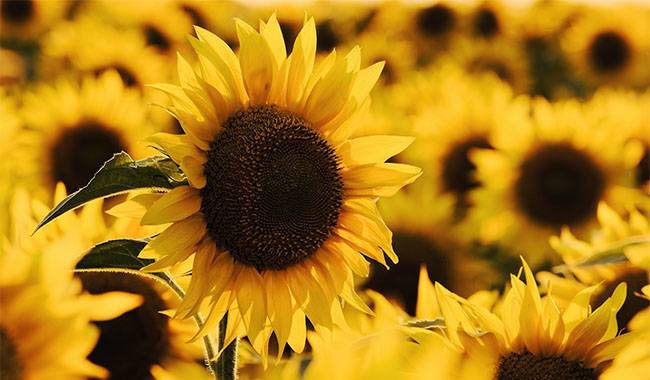
ENVIRONMENTAL REQUIREMENTS OF SUNFLOWER
Sunflower is a plant native to long heat periods and abundant sunshine, requiring heat, light, fertile soil, and moisture. The vegetative duration of sunflower is 80 to 140 days, depending on the variety. Therefore, sunflowers usually grow outdoors and produce good yields only if the climatic and agronomic conditions in a particular part of the world meet their requirements.
If the overall climate of an area is suitable for sunflower growth, but frosts of 21-25°F (-6 to -4°C) occur each spring, agricultural experts do not recommend growing this food crop, especially for mid-to late-maturing varieties. During the long growing period (100-140 days), the crop will remain incomplete and not mature.
Temperature requirements for sunflower
Sunflowers are best grown in a location that is not exposed to shade and is not exposed to the constant wind. In the shade, sunflowers become elongated and bend toward the sun, forming small inflorescence baskets and crushed sunflower seeds.
Sunflowers require 68-80°F (20-27°C) for normal growth and development. Sunflower seedlings are hardy and can tolerate air temperatures as low as 21-23°F (-6 to -5°C), but they need to heat the soil to 46-53°F (8-12°C) to germinate.
Sunflower requirements for lighting
Sunflowers are neutral to the length of sunlight, but they respond positively to daylight during flowering. If the light intensity is high during this period, sunflowers will enter the generative phase of development earlier; in cold foggy, and rainy weather, the process of entering the next stage is delayed. Harvest develops and matures at a later time. Therefore, sunflowers should be sown on well-lit plots, avoiding even temporary shade, and protected from the wind.
Water requirements of sunflower
Sunflower needs a lot of water to form its vegetation and to provide necessary nutrients for its reproductive organs. This is especially true during the early development of sunflowers when their roots are in the topsoil and are often affected by dry weather. At the same time, the sunflower is drought-resistant. As an adult, it is not afraid of heat because its strong root system is able to extract water from the lower soil layer of 10-13 feet (3-4 meters). Sunflower needs to be watered regularly until the flowering period, and then its usage is reduced. Watering is done according to the requirements of weather conditions (long hot periods, dry winds, etc.).
Soil requirements for sunflowers
The soil conditions for timely fertilization do not play a fundamental role in sunflowers. However, the crop prefers black soils, sandy loams, floodplains, and loesses. (Loesses are macroporous soils containing calcium carbonate and exhibit settling characteristics when soaked with water under load). Sunflower grows well on humus and deciduous soils. The optimum soil acidity is pH=6.5-7.0-7.2. They cannot grow in heavy clay, acidic, and saline soils.
SUNFLOWER SEED GROWING TECHNIQUES
When a sunflower is planted in a vegetable rotation, it must return to its previous location no sooner than 6-8 to 10 years after harvest. The longest rest period (up to 10 years) is required if there is an infestation in the vegetable garden. It is preferable to plant sunflowers in shallow-rooted predecessors so as not to dry out the deep soil, whose moisture is necessary for sunflowers.
Undesirable from this point of view are sunflower precursors of alfalfa, sugar beet, and perennial grasses. When selecting precursors, look for crops with common pests and diseases (soybeans, peas, canola, tomatoes, onions, and beans).
Sunflower’s best neighbors and predecessors are potatoes, sweet corn, and others that can be used for fall soil preparation for sunflower. Tall grasses planted outside the crop rotation (by hedges, on wasteland) are good neighbors.
Soil preparation for sunflowers
The preparation of sunflower plots depends on the soil type, the condition of the plot, and its fertility. On all types of soils, preparation in the fall is weed removal and tractor removal by previous generations.
- In areas with long warm autumn, clean areas are usually re-tilled 6-8inch (15-20 cm). Heavy soil should also be turned over. Prior to digging, tilled soil materials such as humus, compost, peat, and topsoil should be used.
- Light soils (deciduous soils, sandy loams) cannot be re-cultivated. Till or deep hoe at 3-4inch (8-10cm), sow fall green manure, and embed it in the soil when a 2-3inch (6-8cm) high green mass is obtained. Green manure can be left until spring. Then, weed and incorporate into the soil in the spring or dig immediately no deeper than 4-6inch (10-15 cm).
- Apply humus or mature compost (0.5-1 bucket/11 sq. ft.) in the fall if organic fertilizer was not applied to the garden beds in previous years of crop rotation.
- If necessary, apply mineral nitrogen and phosphorus fertilizer under the excavation or only phosphorus fertilizer, 30 and 40 g/40inch (1 meter), respectively, also without organic matter.
- On chernozems, instead of organic matter, a complete mineral fertilizer (nitrate phosphorus, nitrogen phosphorus, phosphorus, and potassium) of about 50-70 g/11 sq. ft. can be applied. When applying potash, potassium sulfate must be used because sunflower has a negative attitude to chlorides.
Sunflower seeds ready for sowing
Always use seeds from first-generation propagation of the variety and first-generation hybrids for sowing. Given that sunflower is a heterogeneously pollinated crop, harvested homemade material may produce a common specimen with nothing in common with the parent plant. Therefore, it is best to use purchased planting material for sowing.
- Select the same fraction of sunflower seeds for sowing, as this will promote a high simultaneous germination rate of the plant (without being stretched in time).
- If the seeds are purchased in a store, there is no need to prepare them for sowing, as all procedures are already done by the company concerned.
- If the sunflower seeds are homemade, they need to be treated for fungal and bacterial diseases, for example, using a plant-specific disinfectant that can be used as a seed dressing. To protect sunflower crops from iron nematodes, gaucho pesticide is added to the solution.
- At home, it is safer to disinfect sunflower seeds with manganese or bacteriocin solutions, and after drying, treat them with any growth stimulants – immunocytin, rhizobium, etc.
Sunflower sowing
The time of sowing sunflower seeds depends on the climate of the region. Therefore, it is better to determine the time of sowing based on the soil temperature of the sowing layer. The soil temperature in the 2-3inch (5-8 cm) layer during the week should be at least 46°F (8°C). The optimum temperature is 50-53°F (10-12°C).
Sown sunflower seeds germinate at an ambient temperature of 60-77°F (16-25°C). If the temperature exceeds these limits, it is unlikely that any seedlings will germinate. A second prerequisite for sunflower germination is adequate soil moisture. However, if it is too wet, the seeds tend to rot and lose their ability to germinate.
Interesting! Sunflower seeds germinate in the soil for up to 12 years.
The best solution for sowing sunflowers at home is to use nests, observing a distance of 13-18inch (35-45 cm) between nests and 30-40inch (0.8-1 m) between rows, depending on the variety of hybrids. Thicker plants will reduce the size of the inflorescence and seeds. Sunflower seeds are encapsulated to a depth of 1-2inch (3-5 cm). In each nest, place 2-3 seeds. When the 2nd pair of leaves unfold, the seeds are diluted, leaving the strongest seedlings. Weak seedlings are cut off. Do not pull so as not to damage the root systems of neighboring plants.
Sunflower seeds appear on days 8-15. In the case of deep sowing, new shoots can appear on the 20th-25th day. When sowing, 10-15 g of ammonium nitrate can be added directly to the hole, which will speed up the emergence of sunflower seedlings.
SUNFLOWER CARE
The long pre-germination period and slow growth of sunflowers in the initial stages of development and the wide row spacing provided by the sowing program encourage the development of weeds, especially in pressed cultures immediately after germination. Therefore, planned loosening of the soil is necessary to eliminate weeds. They were performed.
- At the sunflower seed germination stage.
- After 2 weeks, or more precisely, when two pairs of leaves are formed.
- When the third pair of leaves appear, the loosening rows are deepened to 4inch (10 cm) apart; during this time, the plants should be soaked to strengthen the root system.
- The next loosening is done at the 5-6 leaf stage; by this time, the plant has reached a height of 12-16inch (30-40 cm); stop loosening when the sunflower reaches 28-30inch (70-80 cm) or closed rows.
- During flowering, it is necessary to perform repeated pruning or install supports under tall sunflower bushes.
Fertilization of sunflowers
Fertilization of sunflowers starts from the third pair of leaves. The first feeding is with 20 to 30 grams of calcium superphosphate and 5 to 10 grams/11 square feet of ammonium nitrate applied between the rows.
The second is done at the beginning of basket formation. Given the large amount of nutrients used by sunflowers in forming the crop, at this stage, you will need to make 2 cups of wood ash and 30 to 40 grams of general-purpose fertilizer per 11 square feet or dilute the cowpea infusion with 1:10 water. Add 20-30 grams of potassium sulfate to each bucket of cowpea working solution. It is during basket formation that the sunflower needs increased amounts of potassium.
The third feeding with potassium sulfate is done at the sunflower seed maturity stage.
Some experienced gardeners recommend providing sunflowers with nutrients for the entire growing period at once when sowing them. This method is best used on soils with a medium and adequate supply of nutrients. Prepare a nutrient mixture that mixes compost, grassy ash, and nitrogen fertilizer at a ratio of 0.5 buckets of compost, 1 cup of grassy ash, and 2 tablespoons of grassy ash per 11 square feet. Apply the mixture directly under the sunflower seeding or distribute it in the planting hole.
For poor soils, it is best to use the fertilization program described above or another program that extends over a period of time.
Watering sunflowers
Sunflower is a heat and drought-tolerant crop, and it does not require constant watering. Irrigation can be applied when the topsoil dries out to 1-2inch (2.5-5cm). At the same time, it must be watered heavily at a high enough rate during 2 to 4 pairs of leaf growth, sunflower basket formation, germination, heavy flowering, and seed maturation. Irrigation water should soak through the soil to the depth of the main roots. Frequent and low watering will not produce the desired results. Lack of water, accompanied by rapid leaf aging, greatly reduces the oil content of sunflower seeds.
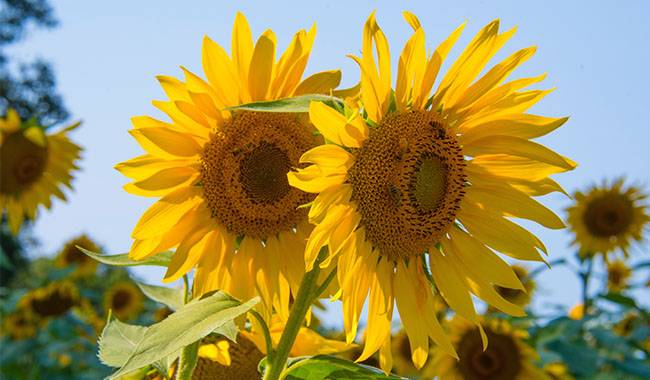
PEST AND DISEASE PROTECTION FOR SUNFLOWER
Sunflower is a favorite crop of pests. The sweet taste of its young seeds and pleasant-smelling stems and leaves attract more than 35 species of pests. About 20 fungal and bacterial infections attack the plants from the moment they germinate and stay with them until harvest. In small plots, it is not appropriate to treat cultures with chemicals, especially in the later stages of development. In this case, it is better to use biological agents that are harmless to humans: bio fungicides and biopesticides.
Diseases of sunflower
The main diseases of sunflower are fungal, bacterial, and viral diseases, including various rots such as white rot, gray rot, carbon rot, root rot, false powdery mildew, downy mildew, rust, Verticillium wilt, Alternaria or black and brown spot and leaf spot. Diseases can cause damage to all parts of the plant, leading to its death over time.
The main measure to protect sunflowers from diseases when grown in a cottage is to observe a crop rotation. In separate plantings, spatial isolation from other crops with similar diseases plays an important role.
Sunflower can be treated with chemicals in the early stages of disease appearance, but it is dangerous for humans and domestic animals. It is better to use biological preparations at home, which are not harmful to humans. These agents can be used for treatment prior to harvest.
Biofungicides combine well with biopesticides in tank mixtures. Among the biological agents for disease control, we can recommend different modifications of phytosporin-potassium nanogel (a powerful natural anti-stress agent that helps to resist drought, disease, and aging) and others. All modifications are directed against fungal-bacterial infections. Some are able to save plants in the form of defeated by neglected diseases (phytosporin rejuvenators).
Products treated with phytosporin-antioxidants can be used immediately in food. Other biological agents have a waiting period of no more than 3-7 days. Treated products can be stored for 2 times longer. All modified phytosporins increase the immunity of plants from re-infestation, stimulate growth and development and can kill not a single species, but a number of fungal and bacterial diseases. In addition to phytosporins, bio fungicides can be used.
Pests of sunflower
The most widespread pests of sunflower are meadow moths, sand flies (moths), sunflower moths, aphids, click beetles, cotton bollworms, crickets, weevils, spider mites, and stink bugs. The roots are damaged by nematodes (larvae of click beetles), beetles, and larvae of the May beetle.
More practical for use at home is a jarring mixture of biological agents from diseases and pests. It is necessary to check the compatibility of the preparation in advance. When used as recommended, fungicides, insecticides, acaricides, and other drugs have a good effect.
The main method of protection, when growing any crop, not only sunflowers, complies with the requirements for growing agrochemicals, which significantly reduces the number of pests and the level of infectious background in the garden plot. The saying is always true: it is more successful to prevent fires than to put them out.
HARVESTING SUNFLOWERS
Pull a long gauze bag over the head of the sunflower to protect it from birds. The long hanging edge will prevent birds from getting to the seeds. There are other methods of protection as well.
On the 35th-40th day after flowering, the accumulation of oil in the sunflower seeds is complete. Moisture evaporates from the seeds, and the seeds reach waxy maturity. When the inflorescence freezes in one position, it is time for sunflower harvest, and the seed basket tilts to the east. At this time, the sunflower leaves wilt and change color from green to dark brown. Once dried, they hang on the same dark brown stems.
If the weather is dry and sunny, the sunflower seed baskets are placed on the stalks to dry. In wet weather, they are cut down and left to dry in the shade. If harvesting is delayed, the seeds are shaken out in a bucket below. Dry under the canopy. They should be cleaned of debris, placed in paper or natural fabric bags, and stored in a dry place. Some gardeners clean the seeds of dust and dirt before drying.
More related information about growing sunflowers plants




